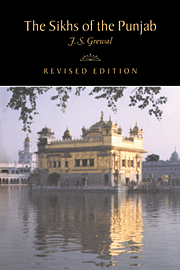Book contents
- Frontmatter
- Introduction
- 1 The Turko-Afghan Rule
- 2 Foundation of the Sikh Panth
- 3 Evolution of the Sikh Panth (1539–1606)
- 4 Transformation of the Sikh Panth (1606–1708)
- 5 Rise to political power (1708–1799)
- 6 The Sikh empire (1799–1849)
- 7 Recession and resurgence (1849–1919)
- 8 In the struggle for freedom (1920–1947)
- 9 Towards the ‘Punjabi Province’ (1947–1966)
- 10 In the new Punjab state (1966–1984)
- Bibliographical essay
- Index
- THE NEW CAMBRIDGE HISTORY OF INDIA
- References
6 - The Sikh empire (1799–1849)
Published online by Cambridge University Press: 28 March 2008
- Frontmatter
- Introduction
- 1 The Turko-Afghan Rule
- 2 Foundation of the Sikh Panth
- 3 Evolution of the Sikh Panth (1539–1606)
- 4 Transformation of the Sikh Panth (1606–1708)
- 5 Rise to political power (1708–1799)
- 6 The Sikh empire (1799–1849)
- 7 Recession and resurgence (1849–1919)
- 8 In the struggle for freedom (1920–1947)
- 9 Towards the ‘Punjabi Province’ (1947–1966)
- 10 In the new Punjab state (1966–1984)
- Bibliographical essay
- Index
- THE NEW CAMBRIDGE HISTORY OF INDIA
- References
Summary
In 1799, a process of unification was started by Ranjit Singh virtually to establish an empire during the first quarter of the nineteenth century. He made use of an efficient army raised and trained more or less like the army of the East India Company. The use of the time-honoured suzerain-vassal polity was equally important in establishing his political control. Paying personal attention to revenue administration and trade in his large dominions he revived prosperity in the Punjab. Extending state patronage to all important sections of the population he attached them to the new empire. In the ruling class too, Hindus and Muslims came to form a substantial element.
The Sikhs formed the dominant element in the ruling class and had the largest share in jāgīrs assigned by Ranjit Singh and his successors. In state patronage in the form of revenue-free land, the Sikhs received a much larger share than Hindus and Muslims, but not at their cost. The state alienated more revenues now in favour of the religious grantees than in Mughal times. In fact Ranjit Singh only extended the pattern first set by Akbar and enlarged later by the early Sikh rulers. Some Sikh members of the ruling class patronized art and literature; a few took personal interest in traditional learning. The number of Sikhs was increasing during the early nineteenth century though only a small number of the new entrants were associated with government and administration or the army.
- Type
- Chapter
- Information
- The Sikhs of the Punjab , pp. 99 - 127Publisher: Cambridge University PressPrint publication year: 1991

